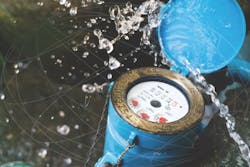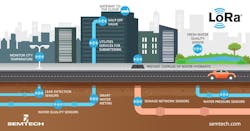About the author:
Rémi Demerlé is director of utilities market for Semtech’s Wireless and Sensing Products Group. Demerlé can be reached at 805.498.2111.
Utility companies are at the forefront of the Internet of Things (IoT) revolution, with smart metering serving as a primary application. According to a report by analyst firm ABI Research, utilities installed 700 million smart meters in 2018, and this installed base is expected to double and reach 1.34 billion meters by 2023.
The shift to more digital technologies did not happen overnight. Traditional utility operations are labor intensive and utilize subjective measurement by field personnel. In areas that are in dense urban environments, indoors or even underground, implementing a smart metering solution can be difficult for many wireless technologies.
Over the last decade, a number of utility service providers have adopted automated meter reading (AMR) solutions that leverage hands on data collection methods using short-range data transferring capabilities of connected meters. The market demand for increased efficiency is pushing data collection beyond these systems to fixed network connectivity via advanced metering infrastructure (AMI) based on the IoT.
When switching from ARM to AMI, public network operators are better suited for the transition because they can match utility requirements by providing a unified price of connectivity in the whole territory. Water is a public service, so it cannot be charged depending on the location or available connectivity. Public networks have to align with utility requirements and provide coverage with proper gateway spacing to ensure good redundancy and sensitivity for radio coverage.
Smart Water Meters Allow for Faster Data Collection
Implementing smart metering infrastructure allows utility companies to collect data faster and more efficiently. IHS Markit forecasts almost 50 million smart water meters will ship globally in 2023, a number roughly four times what was forecasted in 2017.
Industry leaders are helping water utilities stay responsive, lean and resourceful by deploying smart metering systems to replace outdated, labor-intensive processes. Solutions leveraging non-cellular low-power wide-area networking technologies are expected to represent 20% of all smart meters deployed by 2026, according to ABI Research. The following are a few key market drivers and benefits of this type of deployment.
- Remote Metering. Increases operational efficiency by wirelessly measuring usage data in dense urban environments, indoors and underground without the need to check each device manually, eliminating manual meter reading errors.
- Leak Detection. Measures water pressure and flow through piping networks to detect faulty points instantly.
- Customer Service. Increases engagement by allowing customers to visualize and predict their own consumption and detect water leaks and fraud.
- Remote Pump Monitoring. By wirelessly monitoring pressure and usage data, remote monitoring systems reduce energy bills by up to 25% of the water production cost.
- Reduce Waste. Monitors the total water footprint in real-time and provides usage data that incentivizes utility customers to boost efficiency and accelerate sustainability efforts.
- Decrease Theft. Monitors complete smart water networks, including fire hydrants and piping systems, and provides instant alerts of security breaches.
- Data-Driven Decision Making. Accessing and analyzing massive amounts of information enables actionable insights and intelligent decision making across utility operators and the end-user.
Advancing Smart Water Grids
With over 19 years of experience in smart water management, Birdz, a branch of Nova Veolia, has helped advance the remote metering of energy consumption and waste management applications for smart cities.
It provides water utility operators with a range of services, including traditional remote index reading, billing support, leak detection, potential fraud monitoring, subscriber consumption modeling and forecasting. The smart sensor solutions allow customers, including large municipal utility providers, to cut down on non-revenue water and quickly identify issues in their water network.
Birdz also provides a smart hybrid solution that eases transition from AMR to a fixed long range AMI that allows data transfers over low power networks for more efficient utility management and billing.
In 2015, Eau du Grand Lyon, France, implemented a smart water network using Birdz’s smart water sensors. The Métropole de Lyon is responsible for the drinking water supply and sanitation services of more than 2.2 million inhabitants within the city and surrounding area. Eau du Grand Lyon serves as the public water service provider that defines overall strategy, determines the price of water and manages the day-to-day delivery of safe drinking water. The remote water management solution for this included module meters for residential and business facilities, water quality probes and noise correlator sensors on the city’s piping infrastructure.
The smart water sensors access a public network to communicate, transmit data and provide alerts. The grid’s management platform correlates the incoming data and displays daily calculations of several key performance indicators on a customized dashboard. Birdz’s water management approach generated significant benefits for Eau du Grand Lyon, including:
- Identification, geolocation and faster repairs of 1,200 new water leaks in the distribution network;
- 1 million cubic meters of water saved annually in production due to improve performance of the distribution network; and
- Overall 8-point increase of water network efficiency in four years, from 77% in 2014 to 85.2% in 2018.
Having a solution that supports two-way communications, allows the system’s sensors and gateways to send and receive data messages simultaneously. System-to-sensor communication enables managers to automatically detect leaks and other anomalies and automatically shut down problem areas for maintenance.
Implementing a smart metering infrastructure based on smart sensors allows utility companies to collect data faster and more efficiently, streamlining the deployment of smarter, more sustainable solutions.

